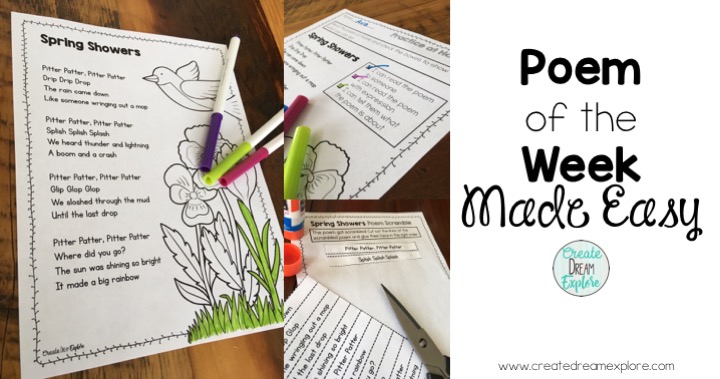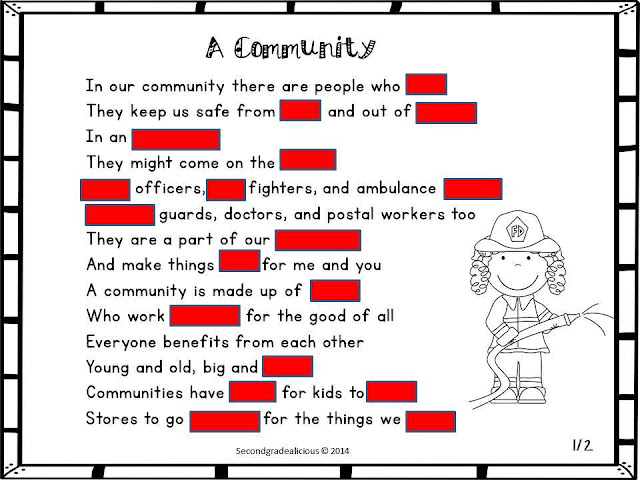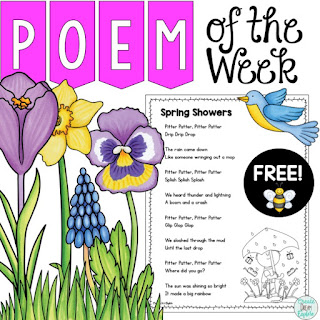April is Poetry Month so I thought I would share a bit about how I use Poem of the Week in my classroom. If you read through to the end, there’s a FREEBIE waiting for you!
When I first started with a new poem each week, we would just read the poem each day and then move on to other literacy based activities. Then as time went on I started creating activities to go along with the poems to help deepen my student’s understanding of the poem. I even created my own set of poems because I wanted the poems to match what we were learning in other areas of the curriculum. For example, I wrote a poem about liquids, solids, and gases for our science unit. For math, I wrote one about fractions and another about measurement. Using poetry is a fun way to introduce new concepts and anchor student learning.
Read on to find out all of the activities we do in my room for poem of the week!
15+ Ways To Use Poem of the Week in Your Classroom:
1) The first thing I do is start by introducing the poem. If you have a document camera or a computer hooked up to a projector that’s the best way to share it. Alternatively, you can print it out and enlarge a copy but this isn’t ideal.
2) I read it aloud to the class first and then we do shared reading as a whole class. While we are reading we talk about any tricky words.
3) Word Work: Once students are familiar with the poem, I send them off to work at literacy stations that are all planned around our poem. For example, we have a word work station where I might put out a Making Words Page:
Or I might put out a nouns, verbs, and adjectives page. Sometimes I have a few choices at a station so students can select which one they want to do OR I assign more than one. I also use these pages for homework sometimes.
Some of my poems target something specific like rhyming words, homophones, compound words, etc. So I might put out a page for that instead.
4) Partner Reading: At the start of the week, students put the new poem into their Poem of the Week folders (we use the 3 pronged folders). One of our literacy stations is partner reading. Their first task is partner reading with the poem of the week and then they can use a book of their choice.
5) Comprehension Station: I always have students do a little bit of comprehension work with the poem. I’m able to gather a lot of information from this. You can really see who understands the poem and who doesn’t. I often use these pages to help me determine my small groups for reading.
6) Meet with the teacher: This is more often than not when I do my guided reading. Sometimes we will follow up with comprehension checks for the poem but generally I use the time while students are happily working on their poetry stations, to meet with my small guided reading groups. The rest of the class are so familiar with the poetry activities that they rarely interrupt.
7) Listen to Reading: I have my students set up on Raz Kids (it’s amazing if you haven’t heard of it!). I am in no way affiliated with Raz Kids. I just really like their program. We also have a poem of the week listen to reading station set up where students scan a QR code from our ipad and it gives them a link to listen to the poem of the week. This took a bit of set up but basically I just recorded myself reading the poem and uploaded it to my Google Drive. You can check that out by clicking here.
8) Read to Self: This station also involves reading the poem first a couple of times and then they can move on to reading their self selected texts.
9) Read to the Class Pet: I don’t have a class pet this year but we do have a therapy dog that visits us once a week and I have students take turns reading to him (he’s the sweetest little chihuahua named Timmy). Timmy is blind and his tongue always just hangs out of his mouth but the kids love him! I also raised baby chicks in the classroom before and had students read to them. You can read about that adventure by clicking here.
10) Tracing Station: I don’t have all students do this one. I save this for my students who really need some work on fine motor skills. Although, for some reason students really love this activity so I do let them do it if they have completed all other work.
11) Guess the Covered Word: One of my favorite activities (and the student’s) to do with our poem of the week is Guess the Covered word. We usually play this as a whole class, not as a station, but you could totally have this set up as a station too. I used to just cut up sticky notes and put them over top of the words but then I smartened up and made a powerpoint file where the boxes slide away when you click the mouse! How neat is that?
12) Unscramble the Poem: Sequencing is an important skill for students to have and I like this activity because it forces them to really reread each part of the poem and think about which order makes sense. I always have them try to put the poem back in order without looking at the poem first (and before they glue the pieces down). Then they can go back to the poem and check their work.
13) Fill in the Blanks: I do have a fill in the blank page as well but this is also something I don’t assign for literacy stations. This often goes in their homework folders.
14) Read to a Big Buddy: We have big buddies that we read to. Generally the big buddy does the reading but my students will read their poems to their buddy first. They love feeling successful with the reading.
15) Practice at Home: I do send home the poem each week for students to read with their families. We focus on fluency and expression when we are reading the poem so I have them go home and practice with a family member. Then they go through their checklist.
16) I recently create a digital version of my poem of the week resource to be used either in class or for distance learning. You can check out the video below and find the resource in my shop.
Do you use a poem of the week strategy in your classroom? What activities do you do with your poems? Let me know in the comments below! I would love to hear from you.
YAY You made it this far!
If you want to check out my FREE Spring Poem of the Week resource click here!















